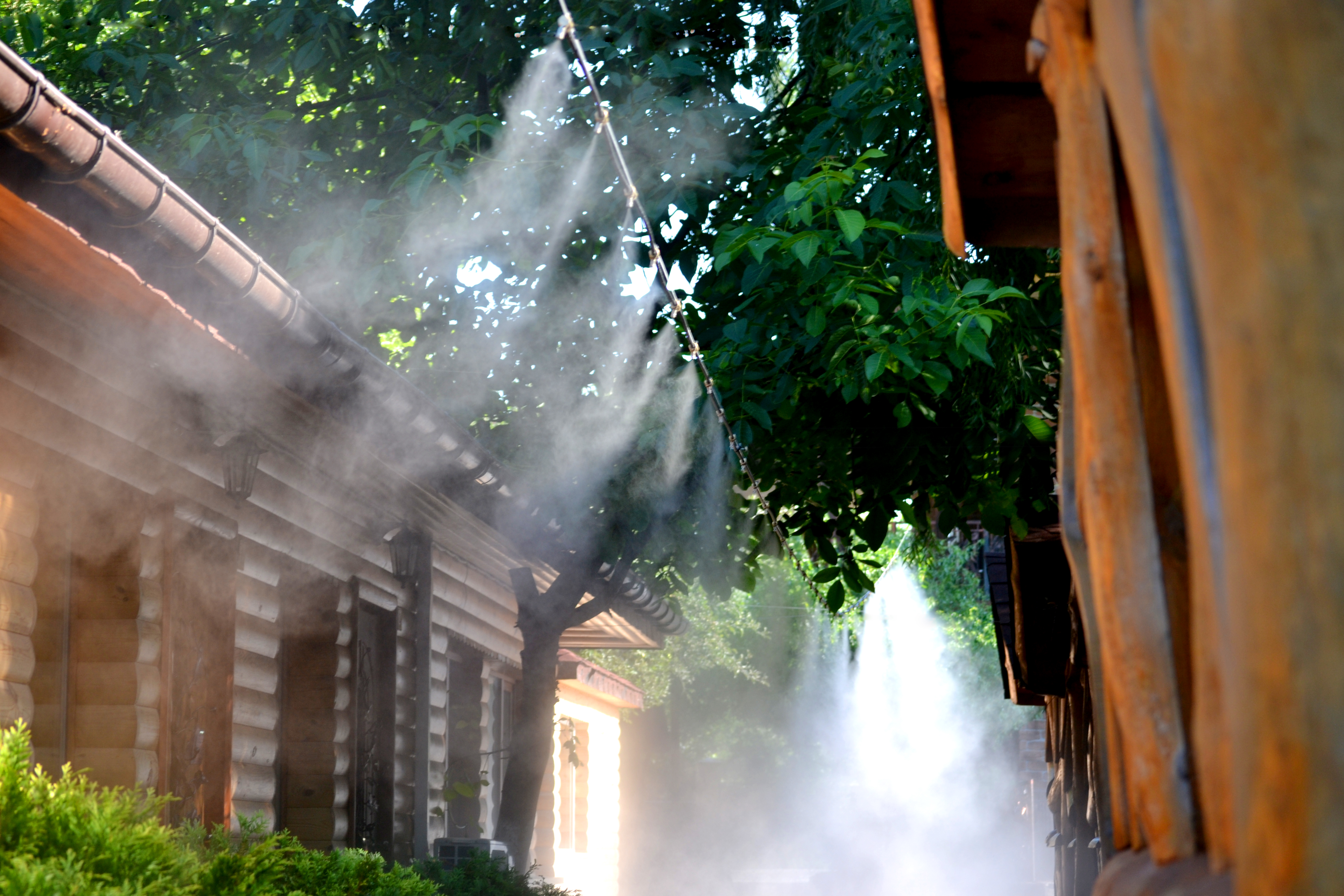
If you've ever wondered how misting systems keep patios and outdoor spaces cool even on scorching days, you're not alone. These systems use water, pressure, and a bit of clever engineering to create a noticeable drop in temperature. But the process is more interesting than you might think, blending physics with practical design.
Components and Design of Misting Systems
A properly engineered misting system depends on several essential components to ensure effective cooling. At the center is a high-pressure pump, which pushes water through durable tubing capable of withstanding pressures up to 100 bar.
The water is then directed to misting nozzles, which break it into fine droplets critical for efficient cooling. These nozzles are typically spaced 2 to 4 feet apart and must be correctly positioned to maximize coverage and performance.
Tubing made of materials like stainless steel or nylon is commonly used for its strength and longevity. Additional components, such as water filters, solenoid valves, and anti-drip nozzles, can be integrated to improve water quality, enhance system efficiency, and prevent leakage.
The Evaporative Cooling Process Explained
When ultra-fine water droplets are released from misting system nozzles, they evaporate rapidly, absorbing heat from the surrounding air. This process, known as evaporative cooling, occurs because the transition of water from liquid to vapor requires energy, which is drawn from the air, resulting in a decrease in temperature.
High-pressure pumps are used to create small droplets, maximizing surface area and facilitating faster evaporation for more effective cooling. The temperature reduction can be significant, with decreases of up to 30°F possible under optimal conditions.
However, the efficiency of evaporative cooling is influenced by humidity levels. In low-humidity environments, evaporation occurs more quickly, leading to better cooling performance. In high-humidity settings, evaporation slows down, reducing the extent of temperature reduction.
Key Advantages of Using Misting Systems
Misting systems offer a practical and efficient solution for outdoor cooling. Through the process of evaporative cooling, these systems can reduce outdoor temperatures by as much as 30°F, enhancing comfort in hot weather.
They consume considerably less energy compared to traditional air conditioning, using approximately 250 watts, which can result in lower energy costs. Additionally, misting systems use less water than many central cooling systems, making them a more resource-efficient option.
Beyond temperature control, they provide secondary benefits such as plant hydration and improved air quality by minimizing dust and allergens. For those seeking a sustainable and versatile option for outdoor spaces, misting systems present a viable choice.
Limitations and Considerations for Misting Systems
Misting systems, while beneficial in certain conditions, come with notable limitations and considerations.
Their effectiveness is reduced in environments with high relative humidity, particularly above 60%, where evaporation is slower and cooling is limited to a few degrees. This contrasts with dry climates, where temperature reductions of up to 30°F are possible.
Additionally, the initial investment for misting systems, especially high-pressure models, can be substantial. Ongoing maintenance is essential to address issues such as hard water buildup and the potential growth of harmful bacteria like Legionella in stagnant water.
Neglecting maintenance can shorten the system's lifespan and pose health risks. These factors should be carefully evaluated before deciding to install a misting system.
Choosing the Right System for Your Space
Selecting the appropriate misting system depends on several critical factors that influence its effectiveness and user satisfaction.
Evaluate the size of your space and its airflow, as proper nozzle spacing—typically between 0.6 and 1.2 meters—is necessary for uniform coverage. The quality of nozzles and the system's water pressure are also important; high-pressure systems, which produce ultra-fine droplets, offer better cooling in hot, dry environments, while mid-pressure systems may be adequate for milder conditions.
Consider the local humidity levels, as misting systems perform best when relative humidity is below 60%. Additionally, ensure the use of filtered water to prevent nozzle clogging and prolong the system's durability.
Lastly, weigh the initial investment and ongoing maintenance costs against your specific cooling requirements and budget constraints.
For applications requiring precise humidity control in industrial settings, a professional fogging system offers superior performance through engineered droplet size and distribution patterns that maximize efficiency while minimizing water consumption.
Installation Steps and Best Practices
After selecting a suitable misting system for your requirements, correct installation is crucial for achieving effective cooling and ensuring the system's durability.
Start by cutting PVC pipes into 24-inch sections and use PVC primer to securely attach the nozzles. Position the nozzles at a height of 8–10 feet, tilting them slightly downward to optimize mist distribution.
Space the nozzles 2–4 feet apart, taking into account factors such as airflow and shaded areas. Install a drain valve to facilitate proper drainage during colder months.
Additionally, conduct regular inspections for leaks and flush the water lines before each seasonal use. Following these steps helps establish a solid basis for ongoing maintenance and consistent cooling performance.
Maintenance Requirements and Troubleshooting
Regular maintenance is essential for ensuring the effective operation and longevity of your misting system.
To prevent clogs and maintain performance, clean nozzles periodically using a vinegar-water solution to dissolve mineral deposits. Inspect hoses and fittings for leaks, and promptly replace any damaged nozzles to maintain consistent cooling.
Before the start of each season, flush the system to remove debris and ensure unobstructed water flow. In regions with cold winters, drain and winterize the system to protect against freeze damage.
Additionally, perform routine visual checks for dust accumulation and verify that the water tank is adequately filled to prevent operational disruptions.
Water Consumption and Energy Efficiency
Misting systems utilize water to provide cooling, yet they're significantly more efficient in terms of energy and resource consumption compared to traditional air conditioning units.
For large outdoor areas, these systems typically consume between 50 and 100 liters of water per hour, depending on the type of nozzle and pressure settings.
In contrast, air conditioning units require 3 to 5 kilowatts of electricity per hour, while misting systems operate on approximately 250 watts, resulting in up to 80% lower energy use.
Additionally, the water used by misting systems is often less than the amount indirectly required for the electricity generation needed to power AC units.
This combination of reduced energy and water consumption positions misting systems as a practical and sustainable option for cooling.
Popular Applications and Environmental Suitability
Misting systems are valued for their energy efficiency and minimal water consumption, making them suitable for various outdoor settings.
They're commonly used in places like amusement parks, hotels, and restaurant patios to provide cooling relief on hot days. In arid climates, these systems are particularly effective, capable of reducing temperatures by as much as 30°F, thereby enhancing comfort in outdoor spaces for events, gatherings, or personal use.
However, their performance is less significant in humid areas, where misting fans might offer a more practical cooling solution.
When selecting a misting system, consider the local climate and specific outdoor cooling requirements to ensure optimal results.
Conclusion
Misting systems give you an efficient and cost-effective way to beat the heat, whether you’re cooling your patio, greenhouse, or commercial space. By understanding how they work and what conditions make them most effective, you’ll be able to choose, install, and maintain the right system for your needs. Remember to consider local humidity, water quality, and maintenance to get the best results—then sit back, relax, and enjoy a cooler, more comfortable environment.
